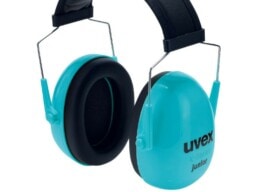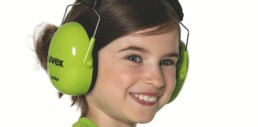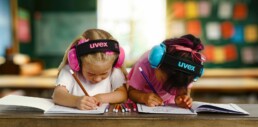Whether at carnival parades, concerts, building work in the house, the annual New Year’s Eve fireworks display, major sporting events or everyday kindergarten or school life: (young) children are constantly exposed to excessive volumes of noise that damage their hearing if they do not wear hearing protection. Among other things, this results in a growing number of people with hearing impairments worldwide, according to the WHO. The hearing of babies and children is particularly sensitive, as it is still developing in the first few years of life and is learning to process environmental stimuli correctly.
It is therefore particularly important that children and babies are not exposed to high noise levels; excessively loud noise levels should generally be avoided. This is often difficult to realise in everyday life, which is why special hearing protection products for children have been developed that are specially designed for small children’s heads.
In this article, we inform you about the sources of noise that are harmful to hearing and our high-quality children’s hearing protection products.
Do the harmful volume ranges of children differ from those of adults?
While adults’ hearing is permanently damaged at a volume of 80 to 85 decibels – which is about as loud as an electric lawnmower – babies and children should not be exposed to volumes above 75 decibels, which corresponds to normal road traffic noise. The pain threshold for children’s and adults’ hearing is around 120 decibels. One problem is that some children’s toys such as toy guns, whistles, toy trumpets or a bursting balloon can briefly reach peak levels of up to 160 decibels. Even short bursts of noise can cause damage to children’s hearing!

On what occasions is hearing protection recommended for toddlers and babies?
Children’s hearing protection is important in any situation in which the limit value of 75 decibels is exceeded and children are exposed to loud noise levels over a long period of time. It is therefore advisable to fit your (small) child with earmuffs, which are often popularly known as Mickey Mouse hearing protection. This protects children from hearing damage when they are in the following places or carrying out the following activities:
- Concerts (both rock music and classical concerts)
- cinema visits
- Fairs or other festivities in a marquee
- Large sporting events, such as football matches in stadiums
- Setting off fireworks (up to 150 dB possible!)
- (Carnival) parades
- Building or renovation work (also for neighbours in the same house)
- Music lessons (drums)
- School (concentration phases during project work)
Another area is noise pollution in everyday life: If your baby or child has toys that emit noises or sounds, these should be kept at a distance of at least 2.5 cm and should not exceed an average value of 60 to 70 decibels. The problem is that children can often have their toys right next to their ears and therefore the decibel exposure can be higher.
In addition, even brief exposure to loud noises, such as toy guns, toy trumpets or whistles, can damage children’s hearing! Furthermore, portable audio devices such as smartphones or MP3 players from which music is listened to via headphones should be checked: What is the maximum volume of the device? Is it possible that my child will turn up the volume independently if there are loud noises in the neighbourhood? For these devices, the prescribed maximum value for use according to DIN EN 60065 is 85 decibels. However, the volume of some audio devices can also be increased and reach a harmful 100 decibels!
Finally, it can have a negative effect on children’s hearing if there is a constant, high noise level at home, for example due to a running television, music, loud kitchen appliances, lawnmowers or hoovers. Please note that musical instruments are also very loud – especially for the musician themselves, as they are close to the instrument.

What type of children's hearing protection are suitable for toddlers and babies?
Basically, uvex offers all types of hearing protection such as earmuffs, earplugs and customised ear moulds.
Earplugs are not recommended for babies and small children, as the ear canal is still developing and no pressure should be built up inside the ear. In addition, correct placement in the ear is difficult to check and there is a risk of swallowing for small children due to the small size of the earplugs.
Ear muffs are particularly suitable for children, as they enclose the ear from the outside and do not sit in the ear canal. It is important to ensure that the ear muffs fit correctly: Both ears must be completely covered.
The hearing protection should also be suitable for children. This ensures that the contact pressure is not too strong, as children’s bones are still soft and can be deformed if too much pressure is applied. The headband should also be adapted to the size of children’s heads and have soft padding.
First and foremost, it must be an approved, certified hearing protection product. This can be determined by checking the required product labelling.
The following labelling must be present on the product:
- CE mark with 4-digit number
- SNR value (attenuation performance of the hearing protection)
- EN 352
In addition, high-quality materials are important – especially for babies – so that the child does not ingest any harmful substances when wearing the hearing protection.

What makes good baby and child hearing protection?
The uvex K-junior earmuffs have been specially developed for children’s heads. Thanks to the smaller, padded and infinitely adjustable headband, it is ideal for children from the age of two and can be worn well into adolescence. The low weight and the very soft ear sealing cushions, which mould to the shape of the head, ensure good wearing comfort and a very good seal. The child-friendly colour design, such as pink or sky blue, distinguishes these ear muffs from conventional protection products.
Our hearing protection earmuffs for children from the age of two, the uvex k junior, also impress with
- an attenuation value of 28 decibels
- lightweight design
- replaceable soft ear sealing cushions (PVC-free)
- a high-quality, padded textile headband
- a certified protective product in accordance with EN 352-1
However, it is important that even with hearing protection, children should not be exposed to high noise levels unnecessarily and for too long. The wearing time should be kept as short as possible due to the soft bones of children!
Buy high-protection hearing protection for your (small) child from uvex
Protect your (small) child from hearing damage in everyday life and at special events and buy comfortable, lightweight children’s hearing protectors from uvex! When using the ear muffs, make sure to replace the sealing cushions every six months. It is best to check toys with noises, your child’s music headphones and the noise level at events yourself first to prevent hearing damage to your children. If you are worried about hearing damage or simply want to be on the safe side, you can also take your child to a hearing aid acoustician. A simple noise protection measure for your child at home can also be to interrupt the constant background noise of music, television or other devices and to take quiet periods so that their hearing can recover.
In addition to children’s hearing protectors, we also have other protective products for children such as cycle helmets, riding helmets, riding gloves, sports goggles, sunglasses and more in our range.
